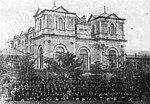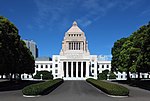Prime Minister's Official Residence (Japan)

The Prime Minister's Official Residence is the official workplace and residence of the Prime Minister of Japan. It is commonly referred to as Sōri Daijin Kantei (総理大臣官邸), Shushō Kantei (首相官邸), or simply Kantei (官邸). Located at 2-3-1 Nagata-chō, Chiyoda-ku, Tokyo 100–8968, it is diagonally adjacent to the National Diet Building.The term Kantei is used as a metonym for the office of the Prime Minister of Japan and for the Prime Minister's advisors and administration in general. In addition to being the principal office and residence of the Prime Minister, the building also serves as the principal office of the Chief Cabinet Secretary and their Deputy, the location of Cabinet meetings, and is also the location of a national crisis management center.
Excerpt from the Wikipedia article Prime Minister's Official Residence (Japan) (License: CC BY-SA 3.0, Authors, Images).Prime Minister's Official Residence (Japan)
東京都道二五五号線, Chiyoda
Geographical coordinates (GPS) Address Website External links Nearby Places Show on map
Geographical coordinates (GPS)
| Latitude | Longitude |
|---|---|
| N 35.673 ° | E 139.743 ° |
Address
首相官邸
東京都道二五五号線 1
100-8968 Chiyoda
Japan
Open on Google Maps









